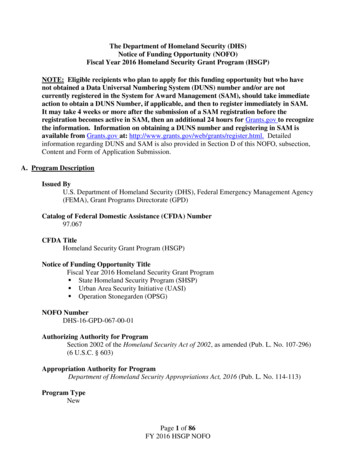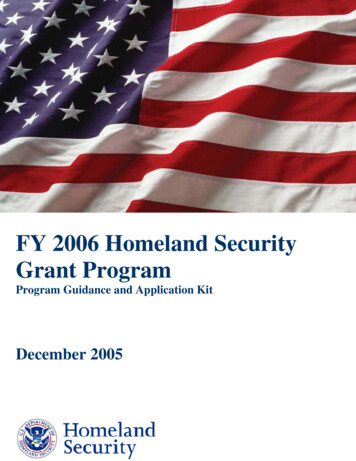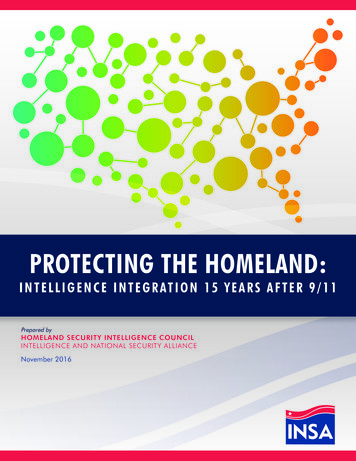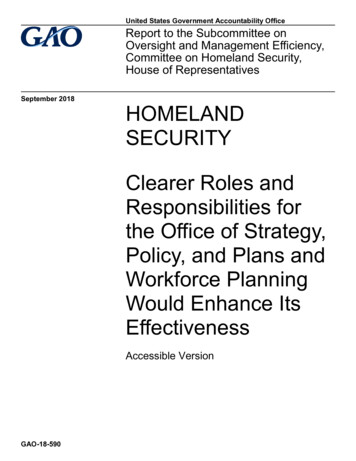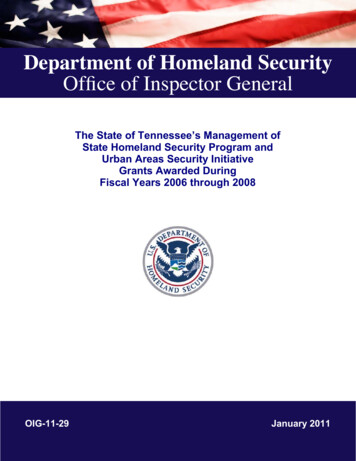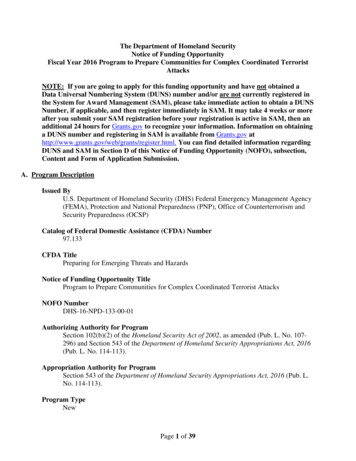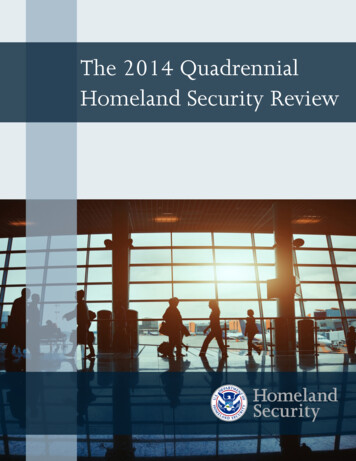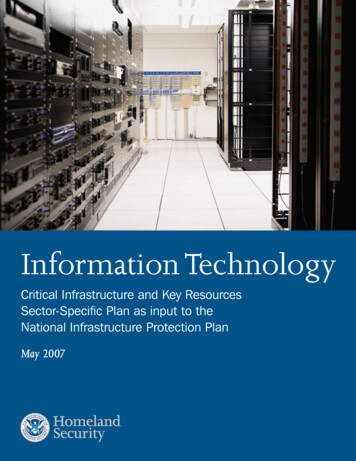
Transcription
Information TechnologyCritical Infrastructure and Key ResourcesSector-Specific Plan as input to theNational Infrastructure Protection PlanMay 2007
Information Technology Sector GovernmentCoordinating Council Letter of ConcurrenceThe National Infrastructure Protection Plan (NIPP) provides the unifying structure for the integrationof critical infrastructures and key resources (CI/KR) protection efforts into a single national program.The NIPP provides an overall framework for integrating programs and activities that are underwayin the various sectors, as well as new and developing CI/KR protection efforts. The NIPP includes 17sector-specific plans (SSPs) that detail the application of the overall risk management framework to eachspecific sector.Each SSP describes a collaborative effort between the private sector; State, local, and tribal governments;nongovernmental organizations; and the Federal Government. This collaboration will result in theprioritization of protection initiatives and investments within and across sectors to ensure that resourcescan be applied where they contribute the most to risk mitigation by lowering vulnerabilities, deterringthreats, and minimizing the consequences of attacks and other incidents.Over the past year, the Department of Homeland Security (DHS) worked closely with members ofthe Information Technology (IT) Government Coordinating Council (GCC), including representativesfrom the Departments of Commerce, Defense, Justice, State, and Treasury, the Office of the Director ofNational Intelligence, the Office of Management and Budget, and the National Association of State ChiefInformation Officers, to develop the IT SSP in partnership with the IT Sector Coordinating Council(SCC). GCC members contributed time and expertise to develop and finalize the IT SSP and will: Support the concepts and processes outlined in the IT SSP to carry out their assigned functionalresponsibilities regarding the protection of CI/KR as described herein; Work with DHS, as appropriate and consistent with their own agency-specific authorities, resources,and programs, to implement programs that enhance CI/KR protection; Cooperate and coordinate with DHS, in accordance with guidance provided in Homeland SecurityPresidential Directive 7, as appropriate and consistent with their own agency-specific authorities,resources, and programs, to facilitate CI/KR protection;Information Technology Sector Government Coordinating Council Letter of Concurrence
D evelop or modify existing interagency and agency-specific CI/KR plans, as appropriate, toincorporate concepts and actions outlined in the IT SSP; and D evelop and maintain partnerships for CI/KR protection with appropriate State, regional, local, tribal,and international entities; the private sector; and nongovernmental organizations.DHS looks forward to continuing to work in partnership with IT GCC and IT SCC representatives andother Sector security partners on the implementation of the IT SSP.Sincerely,Robert B. StephanAssistant Secretary forInfrastructure ProtectionNational Protection and Programs DirectorateDepartment of Homeland SecurityCo-Chair, IT GCCiiGregory GarciaAssistant Secretary for Cyber Securityand CommunicationsNational Protection and Programs DirectorateDepartment of Homeland SecurityCo-Chair, IT GCCInformation Technology Sector-Specific Plan
December 29, 2006The Honorable Robert B. StephanAssistant Secretary for Infrastructure ProtectionU.S. Department of Homeland SecurityWashington, D.C. 20528Subject: Letter of Coordination, Information Technology Sector Specific PlanDear Mr. Assistant Secretary:The members of the Information Technology (IT) sector, organized through our Sector CoordinatingCouncil, the IT-SCC, share a commitment to improving America’s homeland security through ourstewardship of critical technology infrastructures. Furthering our public-private partnership withthe Department under the framework of the National Infrastructure Protection Plan (NIPP), in 2006,members of the IT-SCC voluntarily organized to work with the government to develop an IT-SectorSpecific Plan (SSP). IT-SCC members committed substantial resources, and working together with DHS’National Cyber Security Division (NCSD), we developed a plan document that details improvementsthat will enhance national capabilities for (1) prevention and protection through risk management,(2) situational awareness, and (3) response, recovery and reconstitution of America’s informationtechnology infrastructure. The resulting plan represents the most comprehensive joint planning effortundertaken by IT-Sector public-private security partners.Having built consensus for the key elements of the plan, the IT-SCC believes that the document’sgoals and objectives—while ambitious—chart a course for long-term collaboration with the Federalgovernment, including the Department of Homeland Security. The IT-SSP identifies important specificopportunities for collaborative efforts between and among the private sector, State, local and tribalgovernments, nongovernmental organizations, and the Federal Government. By working together,private and public IT-sector security partners can prioritize protective initiatives and investmentswithin and across sectors. Such collaboration can ensure that limited government resources areapplied effectively and efficiently. Over time this will mitigate risks by reducing vulnerabilities,deterring threats, and minimizing the consequences of incidents. Creating a value proposition for bothgovernment and private sector participation in this process is critical to fostering increased resilienceacross shared infrastructures and the supply chains that enable critical IT Sector functions.Information Technology Sector Coordinating Council Letter of Coordinationiii
Achieving the goals and objectives of the SSP will present some challenges for both public and privatesecurity partners. For example, determining, identifying, and obtaining the necessary resourcesrequired to perform national level risk assessments of critical IT sectors functions, enhance incidentresponse programs, or develop new programs to support recovery and reconstitution will requireworking closely with Congress, to prioritize DHS programs (or eliminating unnecessary programs) tomeet the agreed upon objectives of the SSP. Similarly, private enterprises will work to develop businesscases to make investments of time and resources of their own in support of SSP objectives.Of particular importance to our sector and this Plan in relation to the companion documents developedby our peer Critical Infrastructure sectors is our approach to the identification of sector facilities in theNational Asset Database (NADB). IT-SCC members appreciate DHS’ recognition that the unique andvirtual nature of critical IT-sector functions do not translate easily into NADB entries. The criticality ofsector functions is situational and dependent on their utilization. Accordingly, the sector is generallyfocused on a threat-scenario-driven risk assessment approach to ascertaining IT Sector Critical Functionsand sub-functions, rather than simply cataloging specific or generic assets owned or operated byindividual sector members. Any information entered into the NADB should reflect this industry-led,top-down risk assessment approach based on the identified Sector Critical Functions, and be based uponthe decision of individual industry owners and operators acting in cooperation with the Departmentand other agencies. Through the implementation of the IT SSP risk management process, the IT Sectorwill work with DHS to understand and protect systems, networks, and functions which have uniquecharacteristics or play essential roles in ensuring national and economic security and public health,safety, and confidence.The members of the IT community, represented by the IT-SCC, will continue to work with DHS, itsother government partners (federal, state, local, and tribal) and other security partners to develop andimplement the recommendations embodied in this initial iteration of the IT-SSP. It is hoped that thiscollaboration will result in assessments of risk to IT architectures and functions in a way that will helpbetter prioritize protection initiatives and investments within the sector. The members of the IT-SCC,while sharing the goals expressed in the plan, recognize that by our sector’s consensus participation inthe NIPP/SSP process, no specific commitment of individual action can be made.Thank you for your continued support of the IT Sector as we mobilize our constituencies aroundcritical infrastructure protection. We look forward to working in this partnership and to futureinteraction with the other Sector Coordinating Councils both bilaterally and via the Partnership forCritical Infrastructure Security.ivInformation Technology Sector-Specific Plan
Sincerely,Information Technology Sector Coordinating CouncilGuy CopelandChairpersonMichael AisenbergVice Chairpersoncc: The Honorable Gregory T. Garcia, Assistant Secretary for Cyber Security & Telecommunications,U.S. Department of Homeland SecurityMembers of the IT-SCC Executive Committee:Guy Copeland, Computer Sciences Corporation, ChairpersonMichael Aisenberg, VeriSign, Vice ChairpersonLarry Clinton, Internet Security Alliance (ISA), TreasurerRobert B. Dix, Jr., Juniper Networks, Inc., Acting SecretaryDavid Barron, BellSouthKen Watson, Cisco Systems, Inc.Phil Reitinger, Microsoft Corporation(Vacant), Unisys CorporationHoward A. Schmidt, R & H Security Consulting LLCJerry Cochran, Information Systems Security Association (ISSA)Liesyl Franz, Information Technology Association of America (ITAA)James Bean, Verizon, Communications SCC LiaisonDesignated Representatives of the IT-SCC Members:Bell Security Solutions Inc.BellSouth CorporationCA, IncCenter for Internet SecurityCisco Systems, Inc.Computer and CommunicationsIndustry AssociationComputer Sciences CorporationCyber Security Industry Alliance(CSIA)Computing Technology IndustryAssociationEWA Information & InfrastructureTechnologies, Inc.Electronic Industries Alliance (EIA)Entrust, Inc.IBM CorporationInformation Systems SecurityAssociation (ISSA)Information Technology Associationof America (ITAA)Intel CorporationInformation Technology - InformationSharing & Analysis Center (IT-ISAC)International Systems SecurityEngineering Association (ISSEA)Internet Security Alliance (ISA)Information Technology Sector Specific Plan Letter of CoordinationInternational Security Trustand Privacy Alliance (ISTPA)KPMG LLPLockheed MartinMcAfee, Inc.Microsoft CorporationNTT AmericaR & H Security Consulting LLCSeagate TechnologySymantec CorporationU.S. Internet Service ProviderAssociation (USISPA)Unisys CorporationVeriSign
Table of ContentsExecutive Summary1Sector Background and Goals2Risk Management2Develop and Implement Protective Programs3Information Sharing3CI/KR Protection Research and Development4Managing and Coordinating Sector Responsibilities4Implementing the SSP and Tracking Progress4Introduction and Purpose5Document Organization71. Sector Profile and Goals91.1 Definition91.2 Scope101.3 Sector Security Goals and Objectives111.4 Partnering for Security121.5 Authorities151.6 Actions151.6.1 Near Term ( 1 year)151.6.2 Long Term (1-3 years)162. Risk Management2.1 Background of the IT Sector’s Risk Environment2.1.1 Various Entities’ Risk Management Approaches2.2 Developing an IT Sector Risk Profile2.2.1 National IT Sector Risk Management Approach2.3 Identifying Critical Functions1718181920202.3.1 Screening and Assessing Consequences202.3.2 Decomposing Critical IT Sector Functions222.4 Assessing Threats, Vulnerabilities, Consequences, and Mitigations222.4.1 Analyzing Threats222.4.2 Assessing Vulnerabilities23Table of Contentsvii
2.4.3 Evaluating Consequences242.4.4 Identifying Mitigations242.5 Prioritizing for the IT Sector Risk Profile252.6 Risk Management Information262.7 Actions272.7.1 Near Term ( 1 year)272.7.2 Long Term (1-3 years)283. Develop and Implement Protective Programs293.1 Current IT Sector Protective Programs293.2 Identification and Implementation of New Protective Programs313.2.1 Establish a Protective Program Working Group313.2.2 Determine Needs and Capabilities313.2.3 Identify Protective Actions323.2.4 Develop an Implementation Plan323.3 Protective Program Performance323.4 Actions333.4.1 Near Term ( 1 year)333.4.2 Long Term (1-3 years)334. Information Sharing354.1 Types of Information354.2 Information Originators and Users374.3 An Enhanced IT Sector Information Sharing Framework394.3.1 Information Sharing Focal Points404.3.2 Policies and Procedures for Sharing and Reporting Incidents414.3.3 Procedures for Protecting and Disseminating Sensitive Proprietary Industry Information414.3.4 Access to Classified and Sensitive But Unclassified (SBU) Government Information424.3.5 Mechanisms for Communicating and Disseminating Information434.4 Actions434.4.1 Near Term ( 1 year)434.4.2 Long Term (1-3 years)455. CI/KR Protection Research and Development475.1 Current IT Sector Research and Development475.2 IT Sector R&D Priorities485.3 Coordinating IT Sector R&D Priorities495.4 Actions51viii5.4.1 Near Term ( 1 year)51Information Technology Sector-Specific Plan
5.4.2 Long Term (1-3 years)6. Managing and Coordinating Sector Responsibilities51536.1 Program Management Approach536.2 Processes and Responsibilities536.2.1 SSP Maintenance and Update536.2.2 Annual Reporting536.2.3 Resources and Budgets546.2.4 Training and Education546.3 Roles and Responsibilities566.3.1 Sector-Specific Agency566.3.2 IT Sector Coordinating Council576.3.3 IT Government Coordinating Council576.3.4 Shared Cross-Sector Cyber Security Responsibilities586.4 Actions586.4.1 Near Term ( 1 year)586.4.2 Long Term (1-3 years)587. Implementing the SSP and Tracking Progress597.1 Tracking Progress Challenges597.2 Measurement Overview597.3 Measurement Approach607.4 Goals and Objectives Measurement607.5 Activities Implementation627.6 Reporting on Progress637.7 Actions647.7.1 Near Term ( 1 year)647.7.2 Long Term (1-3 years)64Appendix 1: List of Acronyms and AbbreviationsAppendix 2: Authorities6569Homeland Security/National Security IT Authorities69National Strategies71Management and Acquisition of Federal Government Information Technology72Information Technology Audit-Related Authorities73National Preparedness and Response Authorities Related to Information Technology74Information Technology Communications Related Authorities74Information Technology Privacy Authorities and Information Protection Related Authorities74International Standards and Guidelines75Table of Contentsix
Appendix 3: Common Risk Management FrameworksAppendix 4: IT Sector-Related Protective ProgramsAppendix 5: Action Items777989List of FiguresFigure 2-1. Developing the IT Sector Risk Profile19Figure 2-2. Notional Risk Priority Matrix25Figure 2-3. Risk Management Information26Figure 4-1. Information Flows37Figure 4-2. Notional Relationship Among Security Partners and Types of Information39Figure 7-1. IT Sector Measurement Approach60Figure 7-2. Notional Gantt Chart to Indicate Goal and Objective Implementation Progress at Q4 200861Figure 7-4. Notional Gantt Chart to Indicate Activity Implementation Progress at Q4 200863List of TablesTable 1-1.Examples of IT Security Partners14Table 2-1.Critical IT Sector Functions and Descriptions21Table 3-1.Protective Program Capabilities that Support IT Sector Goals30Table 4-1.Types of Information Produced by Security Partners (Notional Template)38Table A4-1. Existing Protective Programs that Support the Overarching IT Sector Goals 79Information Technology Sector-Specific Plan
Executive SummaryInformation technology (IT) is central to our Nation’s security,economy, and public health and safety. Businesses, governDaily protective activities by individual sector entities toments, academia, and private citizens are increasingly depenprevent, protect against, and mitigate threats and disrupdent on IT Sector functions and services as are all other criticaltions contribute to the sector’s overall steady state ofinfrastructure sectors’ products and services. The Sector haspreparedness. This plan focuses on public and privatediverse global operations that are interdependent and interconsector planning to enhance the ability of the sector as anected with those of other infrastructure sectors. These operawhole to prevent, protect against, mitigate, and respondtions face numerous, multifaceted, global threats every day.to nationally significant events, technological emergencies,Individual IT Sector entities proactively manage risk to theirand Presidentially-declared disasters that threaten, disrupt,own operations and those of their customers, through constantor cripple IT Sector infrastructure.monitoring and mitigation activities designed to prevent dailyincidents from becoming significant disruptions to nationalsecurity, the economy, and public health and safety. Althoughthe IT infrastructure has a certain level of inherent resilience,its interdependent and interconnected structure presents challenges and opportunities for coordinating public and private sector preparedness activities.Various efforts championed by the public and private sectors have been undertaken to address infrastructure protection andcyber security. The Homeland Security Act of 2002 required the first-ever all-encompassing coordinated national critical infrastructure and key resources (CI/KR) protection effort. Homeland Security Presidential Directive 7 (HSPD-7) identifies 17 CI/KRsectors, including the IT Sector, and requires Federal agencies, coordinated by the Department of Homeland Security (DHS), toidentify, prioritize, and coordinate the protection of the Nation’s critical infrastructure. The National Infrastructure ProtectionPlan (NIPP) and its complementary Sector-Specific Plans (SSP) provide a consistent, unifying structure for integrating existingand future CI/KR protection efforts. They also provide the core processes and mechanisms to enable government and privatesector security partners to work together to implement CI/KR protection initiatives.Public and private sector security partners have an enduring interest in assuring the availability of the infrastructure and promoting its resilience. The IT SSP represents an unprecedented partnership and collaboration between the IT public and privatesectors to address the complex challenges of CI/KR protection. Public and private sector organizations each represent and bringunique capabilities to the partnership, and derive value from the exchange. Successful CI/KR protection is the commitment ofIT Sector public and private sector security partners to share information and provide the tools and capabilities necessary for aneffective partnership. As determined by contracts with those customersExecutive Summary
The IT SSP was collaboratively developed by DHS’ National Cyber Security Division (NCSD) as the Sector Specific Agency(SSA) for the IT Sector and sector security partners, including the IT Sector Coordinating Council (SCC) and IT GovernmentCoordinating Council (GCC). The IT SSP is a planning document that provides guidance on how public and private partnerswill work together to protect IT Sector CI/KR. It does not provide specific procedures for individual Sector entities’ operations and is not designed to guide Federal or State government efforts to respond to events. For the purposes of the IT SSP,“response” refers to individual entity activities as well as joint public and private sector activities, to position the Sector toensure that any disruptions or manipulations of the IT infrastructure are brief, infrequent, manageable, geographically isolated,and minimally detrimental to the welfare of the United States. Federally coordinated response, including activities addressed bythe National Response Plan, will be specifically referenced as such. Although this document is the first jointly developed IT SSP,it will not be the last. Threats and vulnerabilities are continually evolving, and consequently plans and programs for addressingthese must evolve accordingly.Sector Background and GoalsThe IT Sector is composed primarily of virtual and distributedIT Sector Goalsfunctions necessary to provide IT products and services. Thesecritical IT Sector functions are provided by a combination Prevention and Protection Through Risk Managementof entities—often owners and operators and their respective Situational Awarenessassociations—that provide hardware, software, IT systems, and Response, Recovery, and Reconstitutionservices. These entities maintain and reconstitute the network,including the Internet. The Internet encompasses the globalinfrastructure of packet-based networks and databases that usea common set of protocols to communicate. The networks areconnected by various transports, and the availability of these networks and services is the collective responsibility of the IT andCommunications Sectors.The IT SSP provides a framework for identifying and managing Sector risk during the steady-state (i.e., routine day-to-daybusiness operations) to prevent, protect against, mitigate, and prepare for nationally significant events, including those cyber orphysical events, technological emergencies, or Presidentially- declared disasters, that threaten, disrupt, or cripple the IT Sectorinfrastructure. Public and private sector security partners have collaborated to identify overarching goals for the sector that areintended to ensure overall Sector preparedness. Pursuit of these goals requires individual actions by a wide array of public andprivate security partners.Risk ManagementPublic and private sectors are collaborating to address risks thatcould affect the ability of the Sector’s critical functions to support the economy and national security. Given the IT Sector’scomplex and global operations and the diverse and interconnected nature of its supporting infrastructure, the Sector isusing a qualitative, top-down approach that considers the Sectorsecurity goals and objectives and then identifies critical Sectorfunctions. The resulting sector-wide risk approach describedin the IT SSP addresses the three factors of risk as described inthe NIPP—threat, vulnerability, and consequence—and focuseson those IT functions with national consequence. Many enti- IT Sector Critical Functions Provide IT Products and Services Provide Incident Management Capabilities Provide Domain Name Resolution Services Provide Identity Management and Associated TrustSupport Services Provide Internet Based Content, Information, andCommunications Services Provide Internet Routing, Access and Connection ServicesInformation Technology Sector-Specific Plan
ties have robust risk management activities in place. As such, the IT SSP does not provide guidance for individual entities’ riskmanagement activities. Coordination of risk management activities by IT Sector security partners should help focus efforts andresources on ensuring the continued availability of critical IT Sector functions, products, and services and improved resilienceof the nationally critical IT infrastructure.The IT Sector approach to risk assessment consists of three steps: (1) identifying critical functions; (2) assessing threats, vulnerabilities, consequences, and mitigations; and (3) assessing and prioritizing risks. Critical IT Sector functions are identifiedand evaluated using consequences to focus on only those that meet certain thresholds for national significance. By definingcritical IT Sector functions during development of the IT SSP, the IT Sector has completed the first step of the risk assessmentapproach. The IT Sector will then apply threats to their critical functions to identify vulnerabilities. An all-hazards approachthat addresses the spectrum of natural and manmade threats will be used. The IT Sector will complement the traditional threatassessment approach with additional factors based on capabilities and intent independent of known actors to consider emergingnon-traditional threats. Vulnerabilities for critical functions and their applicable specific threat scenarios will be identified andassessed, along with mitigations that reduce specific risk factors.Using HSPD-7 consequence categories and criteria for evaluating nationally significant events, the IT Sector’s approach to consequence assessment identifies impacts on national and economic security and public health, safety, and confidence resultingfrom the disruption or degradation of a critical function. Consistent measurements will be used to evaluate threat, vulnerability, and consequence and enable the comparison of risks across the sector. The outcome of the national IT Sector risk assessmentwill be a prioritization of sector risks according to consequence and likelihood. The IT Sector will focus primarily on risks withhigh consequence and high likelihood.Develop and Implement Protective ProgramsProtective programs include measures or activities that are undertaken by various security partners to prepare for, prevent, protect, respond to, and recover from incidents that have the potential to impact critical IT Sector functions. Current protective programs provide capabilities for reducing vulnerabilities, analyzing threat, sharing information, and managing and responding toincidents. During the initial SSP development process, IT SCC and IT GCC members identified existing protective programs andareas where new programs or enhanced capabilities are needed, including robust coordinated response capabilities; reconstitution of data, communication services, and networks; out-of-band data delivery capability; and cyber grants for State governments.The IT Sector will determine additional protective program needs identified through the risk management process. This processwill be used to address those needs in which no viable private sector solution exists for meeting the need or high transactioncosts or legal barriers would cause significant coordination and/or implementation challenges.Information SharingInformation sharing is a key element to fulfilling the overarching goals of the IT Sector and implementing the NIPP framework.Information sharing enables owners and operators, decision makers, managers, and others to detect, deter, and prevent attacksand incidents; identify trends; assess risks; provide warnings to help mitigate impacts; and coordinate response activities. ITSector public and private sector security partners are focused on building and maintaining trusted relationships based on thesimple premise that, for information to be useful, it must be shared with the right people at the right time. The IT Sector’sapproach focuses on sharing information between and among the government and those individuals who operate, administer,and own the IT infrastructure. These are public and private sector consensus critical IT Sector functions for Government Fiscal Year 2007. Annual planning enables the review and update of thesefunctions to reflect changes in the IT Sector environment.Executive Summary
The IT Sector envisions an enhanced information sharing framework that identifies key focal points for policy and operationalinformation sharing, processes, and procedures, and ways to facilitate access to information. The IT Sector’s vision for an idealor future state of information sharing includes policy, cultural, organizational, and technological conditions that facilitate twoway, decentralized, yet coordinated information sharing.CI/KR Protection Research and DevelopmentIn recent years, numerous committees and organizations haveanalyzed and reported on IT Sector security gaps. The result isa substantial body of work describing these gaps and proposingresearch and development (R&D) priorities to bridge them.The IT Sector leveraged this work to identify IT Sector R&Dpriorities based on the common themes established by prioranalyses.Addressing R&D priorities requires engaging multiple partnersto pool resources to raise awareness and increase coordination. Establishment of an online clearinghouse for exchanginginformation and collaborating on IT Sector R&D priorities andconducting an annual IT Sector R&D workshop may providemechanisms for outreach, review of research projects, consideration of gaps in the execution of national research priorities,and reaching consensus on general government and privatesector requirements. In addition, a common taxonomy forexchanging information on progress toward accomplishing thesector’s goals for each R&D priority can promote understandingacross the IT Sector and further collaboration.IT Sector R&D Priorities Cyber Situational Awareness and Response Forensics Identity Management: Authentication, Authorization, andAccounting Intrinsic Infrastructure Protocols Security Modeling and Testing Control Systems Security Scalable and “Composable” Secure Systems Secure Coding, Software Engineering, and HardwareDesign Improvement Trust and PrivacyManaging and Coordinating Sector ResponsibilitiesAs described in HSPD-7, the DHS is responsible for managing and coordinating IT Sector CI/KR protection activities, includingleading the development of an SSP for the IT Sector. Within the department, this responsibility has been delegated to NCSD.Sector responsibilities include maintenance and update of the SSP, annual reporting, resources and budgets, and training andeducation. Public and private sector security partners have common and unique roles and responsibilities.Implementing the SSP and Tracking ProgressTracking the progress of implementing the actions set forth in this plan is essential to the SSP’s success. A collaborative anditerative process that benefits from the voluntary input of the IT SCC and IT GCC members can track the SSP’s implementationmost accurately and provid
Subject: Letter of Coordination, Information Technology Sector Specific Plan Dear Mr. Assistant Secretary: The members of the Information Technology (IT) sector, organized through our Sector Coordinating Council, the IT-SCC, share a commitment to improving America's homeland security through our stewardship of critical technology infrastructures.

